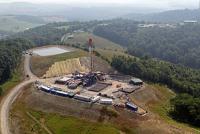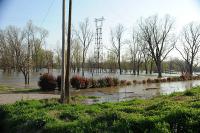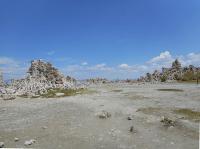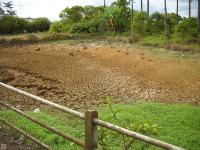-
New material enables more efficient desalination

Engineers have found an energy-efficient material for removing salt from seawater. The material, a nanometer-thick sheet of molybdenum disulfide (MoS2) riddled with tiny holes called nanopores, is specially designed to let high volumes of water through but keep salt and other contaminates out, a process called desalination.
-
-
Declining snow packs put many nations' water supplies at risk

Gradual melting of winter snow helps feed water to farms, cities, and ecosystems across much of the world, but this resource may soon be critically imperiled. Scientists have identified snow-dependent drainage basins across the northern hemisphere currently serving two billion people that run the risk of declining supplies as a result of global warming. “Water managers in a lot of places may need to prepare for a world where the snow reservoir no longer exists,” one scientist says.
-
-
Bad governance is a threat to freshwater supply
Scientists have analyzed nineteen different characteristics critical to water supply management in 119 low per capita income countries and found that vulnerability is pervasive and commonly arises from relatively weak institutional controls. The study sought to identify freshwater supply vulnerabilities using four broad categories: endowment (availability of source water), demand, infrastructure, and institutions (for example, government regulations).
-
-
Managing urban stormwater runoff better
As meteorologists monitor the El Nino condition currently gaining strength in the Pacific Ocean, Californians look with hope to the much-needed rain and snow it could yield. But if Californians are going to make the most of the precipitation, they need to put a LID on it. LIDs, or low-impact development technologies, mimic pre-urban stream functions. Examples are green roofs that absorb and evapotranspire rainfall; rainwater tanks attached to homes and other buildings; and permeable pavement for roads, driveways and parking lots. Rainwater could even be used in the home for toilet flushing and laundry.
-
-
Water security test bed to focus on bolstering municipal water security
Water is the foundation for life. People use water every single day to meet their domestic, industrial, agricultural, medical, and recreational needs. After the September 2001 terrorist attacks, water system security became a higher priority in the United States. The Water Security Test Bed (WSTB) at Idaho national Laboratory can be used for research related to detecting and decontaminating chemical, biological, or radiological agents following an intentional or natural disaster. The WSTB will focus on improving America’s ability to safeguard the nation’s water systems, and respond to contamination incidents and to natural disasters.
-
-
Storms after wildfire degrade water quality
About half of the water supply in the southwestern United States is supplied by water conveyed from forests, which generally yield higher quality water than any other land use. However, forests are vulnerable to wildfire; more than twelve million acres of land, including important forested water-supply watersheds, have burned in the southwestern United States in the past thirty years. Wildfires increase susceptibility of watersheds to both flooding and erosion, and thus can impair water supplies.
-
-
U.S. fracking uses less than 1 percent of total industrial water use nationwide

Energy companies used nearly 250 billion gallons of water to extract unconventional shale gas and oil from hydraulically fractured wells in the United States between 2005 and 2014, a new study finds. During the same period, the fracked wells generated about 210 billion gallons of wastewater. Large though those numbers seem, the study calculates that the water used in fracking makes up less than 1 percent of total industrial water use nationwide.
-
-
Wastewater to irrigate, fertilize, and generate energy
To meet the requirements of Asian cities, researchers are adapting an idea they have already applied in Germany for comprehensive water management: They are developing a concept for reducing water use, treating wastewater and extracting fertilizer for a strip of coastline in the Vietnamese city of Da Nang.
-
-
Helping replenish groundwater by flooding farms in the winter

California is in chronic groundwater overdraft: There is more water being pumped from the ground than filtering in, and the state’s aquifers are shrinking as more growers pump groundwater to keep crops alive. But that fertile farmland may also provide the means for replenishing groundwater to benefit everyone in the drought-stricken state. Researchers at the University of California, Davis, are encouraged by early results from tests to see whether deliberately flooding farmland in winter can replenish aquifers without harming crops or affecting drinking water.
-
-
Snowpack of Sierra Nevada lowest in 500 years, worsening California water woes

Snowpack in California’s Sierra Nevada in 2015 was at the lowest level in the past 500 years, according to a new report. “Our study really points to the extreme character of the 2014-15 winter. This is not just unprecedented over 80 years — it’s unprecedented over 500 years,” said the lead author of the report. On 1 April of this year, California Governor Jerry Brown declared the first-ever mandatory water restrictions throughout the state while standing on dry ground at 6,800-foot elevation in the Sierra Nevada. The historical average snowpack on that site is more than five feet, according to the California Department of Water Resources.
-
-
Innovative method filters seawater in minutes
Researchers have unveiled a cost-effective desalination technology which can filter highly salty water in minutes. The technology is based on membranes containing cellulose acetate powder, produced in Egypt. The powder, in combination with other components, binds the salt particles as they pass through, making the technique useful for desalinating seawater.
-
-
2015 drought costs for California agriculture: Loss of $1.84 billion, 10,100 jobs

The drought is tightening its grip on California agriculture, squeezing about 30 percent more workers and cropland out of production than in 2014, according to the latest drought impact report. In 2015, the state’s agricultural economy will lose about $1.84 billion and 10,100 seasonal jobs because of the drought, the report estimated, with the Central Valley hardest hit. The heavy reliance on groundwater comes at ever-increasing energy costs as farmers pump deeper and drill more wells. Some of the heavy pumping is in basins already in severe overdraft — where groundwater use greatly exceeds replenishment of aquifers — inviting further land subsidence, water quality problems, and diminishing reserves needed for future droughts.
-
-
What would it take to end California’s drought?
The excitement about a potentially rain-bearing El Niño is building, and hopes for a swift end to California’s ongoing drought are multiplying. At the same time, many of us who have worked extensively on water issues in the state fear the momentum and progress made on much-needed water reforms will be lost. This will be unfortunate, because California’s current water situation offers an invitation to expand how we think about water and drought conditions. A more nuanced perspective about what drought means and our water needs can help continue the momentum on the shifts, such as conservation measures and groundwater management, needed to deal with what is certainly an uncertain future.
-
-
Past strategies for managing droughts are obsolete in a hotter, more densely populated world

California’s current extreme drought must be a lesson for managing water in a warmer, more densely populated world, experts say. The Golden State has a long history of successfully managing droughts, but strategies from the past century are now obsolete, they assert. The current drought, which began in 2012, is a harbinger of what is to come. Engineering our way around periodic water shortages will no longer work in a hotter, drier world with ceaseless human demands on water supplies. Our ever-increasing thirst for water coupled with poor management, aging infrastructure and worsening climate change is a recipe not just for wells run dry, but for ravaged forests, extinct wildlife, and more droughts. Targeted research and public policies that move beyond a crisis response mentality are critically needed, the experts conclude.
-
-
Solving the mystery of arsenic-contaminated water
Can water ever be too clean? If the intent is to store it underground, the answer, surprisingly, is yes. In a new study, scientists have shown that recycled water percolating into underground storage aquifers in Southern California picked up trace amounts of arsenic because the water was too pure. The research sheds light on a poorly understood aspect of groundwater recharge with purified recycled water, namely the potential mobilization of arsenic. Arsenic is a naturally occurring element that can cause organ failure and cancer in humans with prolonged exposure above established health thresholds. The findings pose a problem for Orange County, California, which differs from most communities in that it purifies treated wastewater instead of discharging it directly into rivers and oceans – but the problem goes beyond Orange County.
-
More headlines
The long view
Water Wars: A Historic Agreement Between Mexico and US Is Ramping Up Border Tension
As climate change drives rising temperatures and changes in rainfall, Mexico and the US are in the middle of a conflict over water, putting an additional strain on their relationship. Partly due to constant droughts, Mexico has struggled to maintain its water deliveries for much of the last 25 years, deliveries to which it is obligated by a 1944 water-sharing agreement between the two countries.
